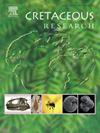An Upper Cretaceous mesophotic coral reef (Gosau Group, Eastern Alps, Austria): Significance for the palaeoreef record
IF 1.7
3区 地球科学
Q1 GEOLOGY
引用次数: 0
Abstract
Cretaceous reefs that record coral growth under mesophotic conditions apparently are very rare. Hereunder we present a middle-upper Coniacian to lower Santonian reef composed mainly of coral platestone that is located within the synorogenic wedge-top succession of the Eastern Alps (Gosau Group, Turonian to Ypresian) near Strobl am Wolfgangsee (Salzburg, Austria).
In the studied reef, an exposed 15–18 m of coral platestone is overlain by a few meters of domestone-mixstone and bioclastic limestones. The platestones display a dense, continuous, interlocked fabric with a matrix of wackestone with planktic foraminifera and calcareous nannoplankton. Bioencrustation of coralla and boring traces are scarce. Hippuritids and radiolitids settled on the corals, but only few developed into adults. The dome/mixstones comprise massive and branched corals, show a packed fabric, and contain intercalated singles and clusters of rudists. In the reefal interval, one helioporid octocoral and 25 colonial scleractinian species (25 % pennular species) were identified. The top bioclastic limestones contain dasycladaleans, Miliolina, Textulariina and rare Rotaliina.
The vertical succession from coral platestones to bioclastic limestones indicates shoaling. The platy-foliaceous shapes and packing of coralla in the platestones, and the scarce encrustation suggest constratal to low-superstratal growth under mesophotic conditions. In the dome/mixstones, toppled corals and rudists indicate episodic disturbance. In Jurassic seas mesophotic reefs were widespread, yet the studied reef is the first Upper Cretaceous example. This contrast in reef style may be attributable to: (1) intensified production and dispersal of chalk; (2) extinction/emigration of Jurassic microsolenids; and, (3) implicit description of Cretaceous mesophotic reefs.
奥地利东阿尔卑斯Gosau群上白垩统中孔珊瑚礁:古岩石记录的意义
白垩纪的珊瑚礁记录了珊瑚在中孔条件下的生长显然是非常罕见的。在此基础上,我们提出了一个主要由珊瑚板岩组成的中上Coniacian到下Santonian礁石,它位于奥地利萨尔茨堡附近的Strobl am Wolfgangsee附近的东阿尔卑斯山(Gosau群,Turonian至Ypresian)的同生楔顶演替中。在研究的珊瑚礁中,暴露的15-18米的珊瑚板岩被几米的国内混合岩和生物碎屑灰岩覆盖。板岩呈致密、连续、互锁的结构,基质为微晶岩、浮游有孔虫和钙质纳米浮游生物。珊瑚的生物结壳和钻孔痕迹很少。河马类和放射性石类在珊瑚上定居,但只有少数发育成成虫。穹顶/混合石由巨大的分支珊瑚组成,呈现出密集的织物,并包含插入的单根和簇状珊瑚。在礁层间,鉴定出1种太阳状的八珊瑚和25种蜂群状的硬珊瑚,其中环状的占25%。顶部的生物碎屑灰岩中含有浅支藻、千粒藻、草粒藻和稀有的轮状藻。从珊瑚板岩到生物碎屑灰岩的垂直序列表明浅滩作用。板状叶的形状和花冠的排列,以及极少的壳层表明在中胚层条件下的低上层生长。在穹窿/混合岩中,倒塌的珊瑚和岩石表明有间歇性的扰动。在侏罗纪海中,中深水礁分布广泛,但所研究的礁是上白垩统的第一个例子。这种礁型的差异可能是由于:(1)白垩垩的生成和扩散加剧;(2)侏罗纪微螺线管的灭绝/迁移;(3)白垩纪中深水礁的隐式描述。
本文章由计算机程序翻译,如有差异,请以英文原文为准。
求助全文
约1分钟内获得全文
求助全文
来源期刊

Cretaceous Research
地学-地质学
CiteScore
4.10
自引率
19.00%
发文量
235
审稿时长
12 weeks
期刊介绍:
Cretaceous Research provides a forum for the rapid publication of research on all aspects of the Cretaceous Period, including its boundaries with the Jurassic and Palaeogene. Authoritative papers reporting detailed investigations of Cretaceous stratigraphy and palaeontology, studies of regional geology, and reviews of recently published books are complemented by short communications of significant new findings.
Papers submitted to Cretaceous Research should place the research in a broad context, with emphasis placed towards our better understanding of the Cretaceous, that are therefore of interest to the diverse, international readership of the journal. Full length papers that focus solely on a local theme or area will not be accepted for publication; authors of short communications are encouraged to discuss how their findings are of relevance to the Cretaceous on a broad scale.
Research Areas include:
• Regional geology
• Stratigraphy and palaeontology
• Palaeobiology
• Palaeobiogeography
• Palaeoceanography
• Palaeoclimatology
• Evolutionary Palaeoecology
• Geochronology
• Global events.
 求助内容:
求助内容: 应助结果提醒方式:
应助结果提醒方式:


